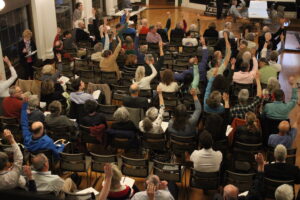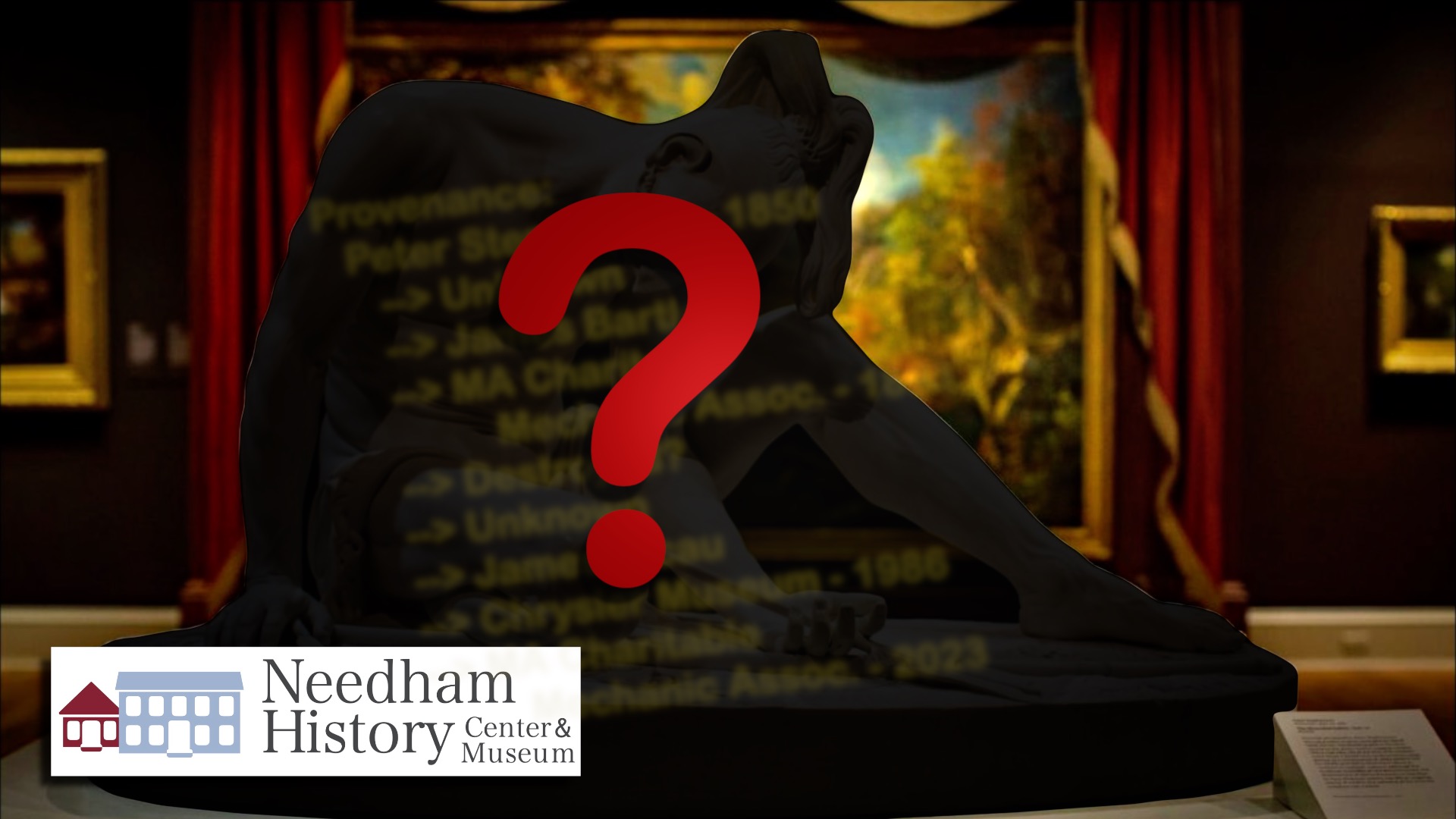
Needham History: The Saga of “The Wounded Indian”
But where was it all those years?
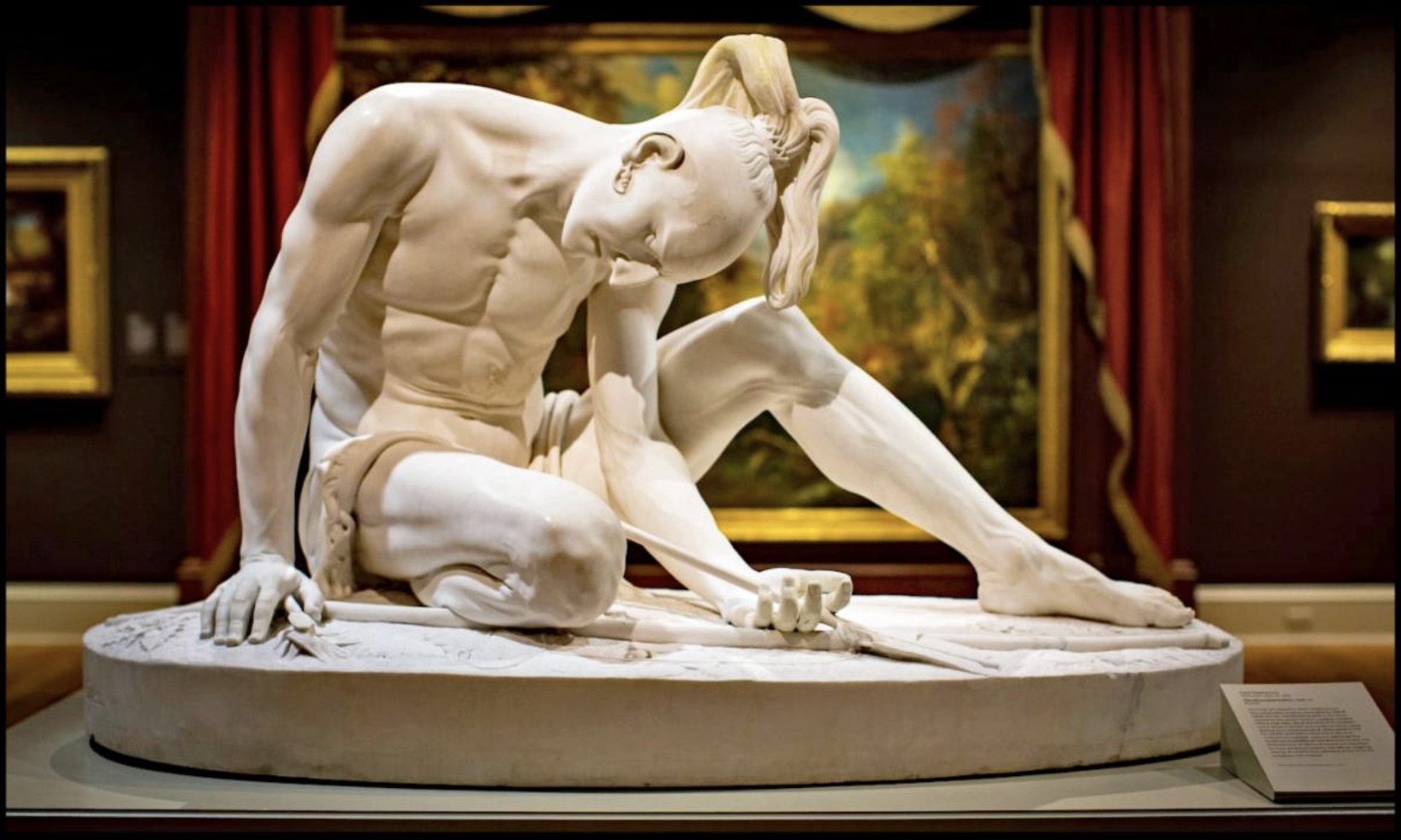
The Wounded Indian, by Peter Stephenson (1850), on display at the Chrysler Museum of Art in Norfolk, VA.
The Saga of ‘The Wounded Indian’
Last summer, most of the major newspapers ran a story about the return of a statue to Boston, a statue that had been missing and thought destroyed for nearly 75 years. It was also a story about the efforts made to fill in the missing years.
The statue is question is known as The Wounded Indian. It was made in 1850 by a Boston sculptor named Peter Stephenson (1823-1860). Stephenson was a relatively minor member of the Boston arts community. He was born in Yorkshire and emigrated to the United States as a youngster. He was originally apprenticed to a watchmaker in Buffalo, NY, but moved to Italy to train as an artist, and settled in Boston where he became known mostly for carving cameos and sculpting portrait busts. He died in an insane asylum in 1860 at the age of 37.
The Wounded Indian was by far Stephenson’s largest and most ambitious work. It is notable for being the first major sculpture to be carved from Vermont marble rather than imported Carrara. It is based in form and subject on the ancient Roman statue, The Dying Gaul (Capitoline Museum, Rome), depicting the fallen warrior with the same delicate respect for his courage and dignity. Like its Roman predecessor, it is also a reflection on the passing of an indigenous culture.
The statue was shown by Stephenson for a couple of years, but he was not able to find a buyer; and then it dropped out of sight for a few decades. In 1893, it was donated by art dealer James Bartlett to the Massachusetts Charitable Mechanic Association in Boston, a trade organization founded by Paul Revere in 1795. The Association provided training in the mechanical arts for poor students and also provided support for the families of deceased members. They had a large building, Mechanics Hall, in Boston on the site of what is now the Prudential Center. In Mechanics Hall they displayed various works of art, science, and craft.
In 1958, the Charitable Mechanic Association was in financial difficulty, so it sold its large Boston property and moved to Quincy. Its collections were dispersed – some items went into storage, others were sold or given to other collections. It was reported at the time that The Wounded Indian was badly damaged in transport and destroyed.
Then in 1999, a researcher looking through an archived album of artworks at the Charitable Mechanic Association’s Quincy site saw something familiar – a statue of a dying Native American warrior. This wasn’t destroyed, he told them – I just saw it in the Chrysler Museum of Art in Norfolk, VA.
The Chrysler had acquired the statue in 1986 as part of a purchase of several statues from a collector named James Ricau. Ricau claimed that he had owned the statue since the 1960s, but was hazy about the details of how and when he obtained it. There was no good explanation for the statues whereabouts between 1958 and 1986.
For a while, the Charitable Mechanic Association was content to leave the statue on display at the Chrysler as long as their ownership was acknowledged. In the few years following, however, disputes over ownership and finances finally led the MCMA to seek its return. As of August 2023, the statue was scheduled for return to Boston. The MCMA has said that they plan to put it on exhibit, but I have not yet seen anything that says where or when this will happen.
OK, I hear you ask – What does this have to do with Needham?
As I mentioned above, the statue was shown by Stephenson for a couple of years, but he was not able to find a buyer; and then it dropped out of sight for a few decades.
As it happens, I know where it was.
In the summer of 2016 I was contacted by a graduate student from MIT who was doing research on the statue and came up with the name William Emerson Baker. She wanted to know whether Baker had ever owned a statue called The Wounded Indian, and if so, where he got it and where it ended up. I did not know at the time that this was part of the MCMA’s research into its ownership of the piece.
Baker did indeed own the statue. In his Guide to the Ridge Hill Farms, the statue appears in the inventory of works displayed in his Floral Art Gardens (page 76): ”Statue, The Dying Indian Warrior. By P. Stephenson. White marble.” There are also two photos of the statue at the Baker estate – one stereo view closeup, and the second a view of the Floral Art Garden with the statue visible in its place.
Baker had acquired the statue in 1877 from the Mercantile Library Association of Boston (not related to the MCMA). The Mercantile Library Association apparently had bought or acquired it from Stephenson himself before 1856. Baker displayed the statue in his gardens from 1877 until his death in 1888. Baker’s widow, Charlotte, rapidly liquidated the estate, and sold off a large number of the statues and movables to the dealer James Bartlett, the Indian among them. In 1893, Bartlett gave it to the MCMA.
Although this information did not solve the problem of what actually happened in 1958, and how The Wounded Indian ended up in the hands of James Ricau, it did help establish that the statue in the Chrysler was the original and not a copy. Plus, I am always delighted when I can find a connection between an apparently-distant story and Needham.
Top: Baker’s Southern Floral Art Garden, from a stereo view. The detail view (inset) and the red arrows show where the statue was located. Baker moved his statues around from time to time, and the Indian was also at one point on the white Balustrade in the background.
Bottom: Stereo view of The Wounded Indian. Baker commissioned numerous photographs of the estate and its features, which he sold to the public as souvenirs. The pine tree background of this picture suggests that it was taken while the statue was still on the Balustrade.
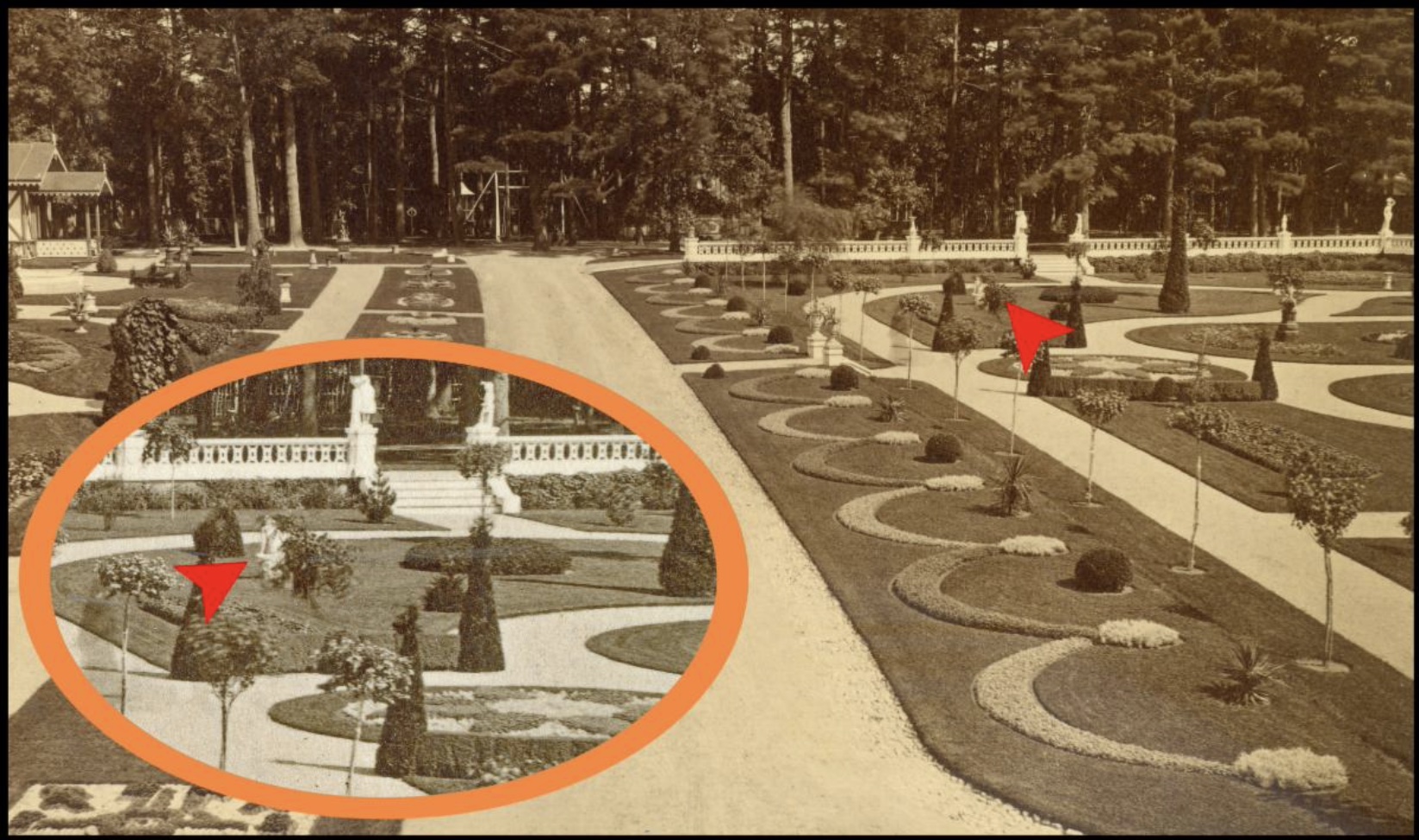
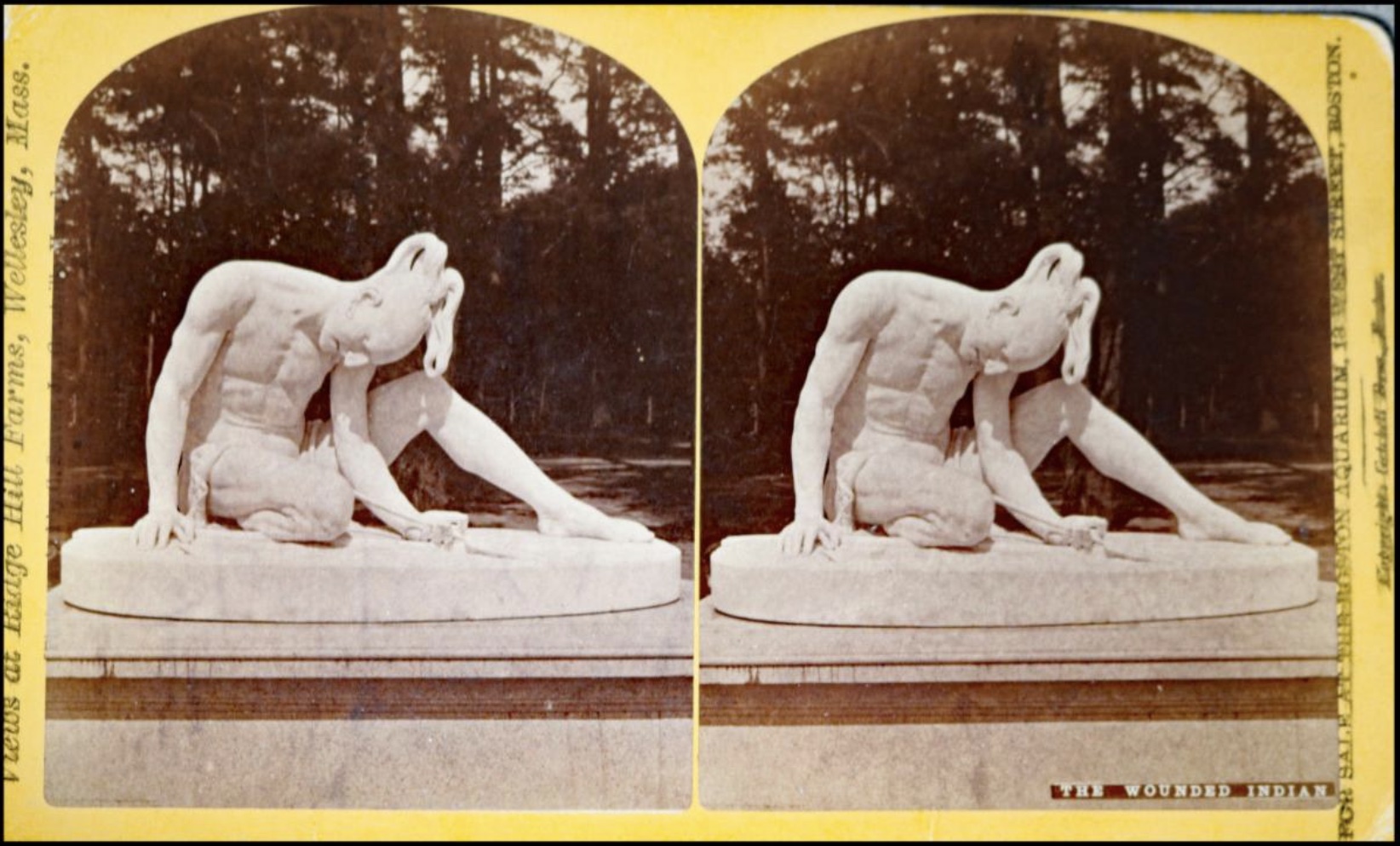
 |
Gloria Polizzotti Greis is the Executive Director of the Needham History Center & Museum. For more information, please see their website at www.needhamhistory.org. |
